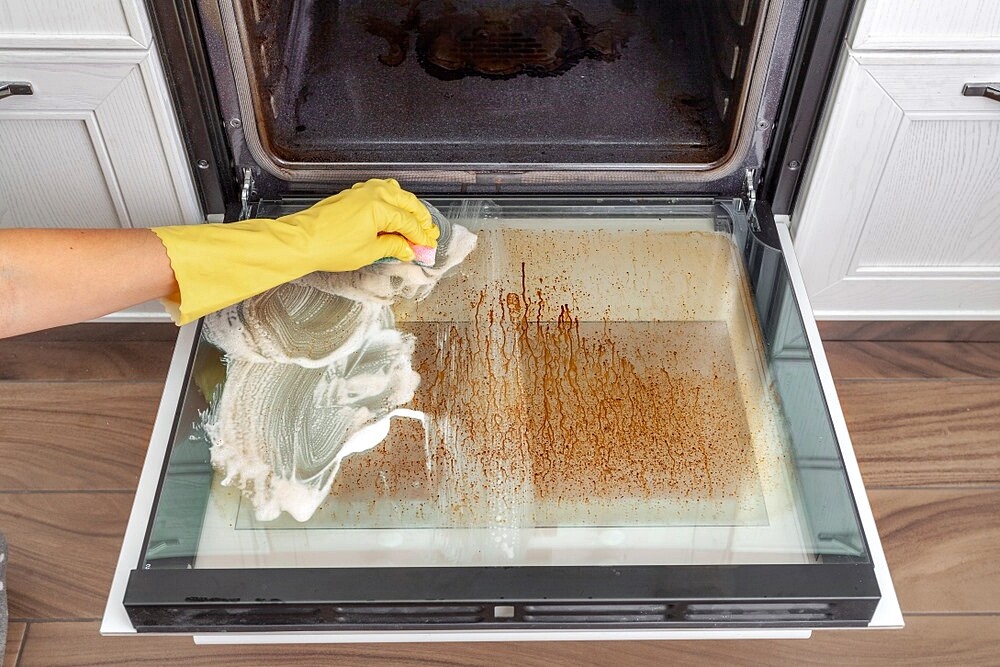Cleaning the oven made easy: We reveal nine tips and home remedies that will make your oven clean again without strenuous scrubbing.
Cakes, roasts, casseroles – the oven is often used. Sometimes something goes wrong and burnt-in fat and gravy leave their marks. The unloved cleaning work is then gladly postponed and the oven is only quickly wiped out.
This gives the food leftovers time to dry out and crust a little more with each baking process. In the end, tough scrubbing with cleaning agents costs time and nerves. Fortunately, we don’t have to resort to chemicals or aggressive oven cleaners to get rid of stubborn dirt.
Cleaning an oven: With these home remedies it works
- Salt: Burnt-on pieces can be easily removed with salt. Wipe the oven with a damp cloth and sprinkle generously with salt. Heat the oven to 50 degrees and wait until the salt is browned. Then let the oven cool down and wipe the salt (including the dirt) out of the oven with a damp cloth.
- Lemon juice: To decalcify the kettle and decalcify the coffee machine, but also to clean the ceramic glass cooktop, lemon juice is suitable, but also to clean the oven. Even though vinegar essence is often used for cleaning, it does not smell very good. But if we mix lemon juice and water in a casserole dish and put it in the oven at 120 degrees, a wonderful scent unfolds and due to the water vapour produced, the grease stains dissolve by themselves. Afterwards, wipe the casserole dish once – that’s it. The microwave can also be cleaned in this way.
- Shaving foam: The oven cleaning also works with shaving foam. Spray the burnt-in stains on the floor and walls with the shaving foam, let it work and then wipe out the oven.
- Baking powder: Who needs chemical oven spray when there is baking powder? It is the home remedy for cleaning par excellence – a true miracle cure for burnt-in areas. Mix a paste of baking powder and water and apply it to the burnt-in stains, let it work and wipe it off with a damp cloth. By the way, baking powder is also suitable for decalcifying coffee machines, kettles and the like.
- Baking soda: The oven can also be cleaned with baking soda – without scrubbing the oven will be spotlessly clean. To do this, generously spread baking soda on the dirty oven door (and walls). Sprinkle some water on the powder and let it soak in for a while. Moisten a cloth and wipe everything down.
The home appliance manufacturer Zanussi has shared this baking soda trick on its YouTube channel, which makes every oven shine again in no time:
Cleaning the oven: 9 more tips
We have other useful tips for easy oven cleaning:
- Avoid soiling: The use of baking paper prevents greasy and burnt-in residues from remaining on the baking tray. For roasts or casseroles, the roaster or casserole dish should be sufficiently large. To avoid overflowing when heating up, it is best to use forms with a high rim and not to fill them to the brim.
- Remove soiling immediately: Wipe off light soiling immediately after baking.
- Soak in crusts: If you have a combi oven with an integrated steam system, you can soak stubborn dirt first by adding steam. This makes it easier to loosen and remove from the surface.
- Cleaning individual elements: Individual elements, such as hanging grids or baking drawers, can be hung out and cleaned separately on many models. This also applies to most oven doors. The glass panes can usually be removed using clamping levers without special tools.
- Clean the rubber seals: The rubber seals of the door should also be cleaned regularly with warm water and a neutral soap. This way the door closes really tightly and heat and energy losses can be prevented.
- Use enamel or ceramic: Baking dishes with enamel or ceramic surfaces are particularly smooth, so that hardly anything sticks.
- Oven with coating: A catalytic coating of the inner walls of the oven is also practical. Here, special catalyst particles are embedded in the coating which decompose greasy soiling from around 200 degrees Celsius during operation. Important: Under no circumstances should the coating be treated with scouring milk, stiff brushes and sponges or steel wool, as otherwise the surface will be damaged and the special cleaning properties lost.
- Pyrolysis in the oven: Ovens with a pyrolysis function are particularly convenient: During this self-cleaning process, the empty oven interior heats up to 500 degrees Celsius. All impurities are carbonized at these high temperatures. What remains are ashes which can be simply wiped away with a damp cloth after cooling down. Depending on the degree of soiling and the set cleaning level, the application takes one to three hours.
- Use oven cleaner: If you don’t have a self-cleaning oven and don’t want to use household remedies, you can remove stronger residues with oven cleaner.

